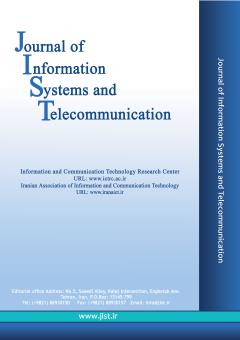Secure Key Management Scheme for Hierarchical Network Using Combinatorial Design
Subject Areas : Wireless Network
Siddiq Iqbal
1
*
![]() ,
B R Sujatha
2
,
B R Sujatha
2
![]()
1 - Department of Electronics & Telecommunication B.M.S. Institute of Technology & Management, Bengaluru, India
2 - Department of Electronics & Communication Malnad College of Engineering, Hassan, India
Keywords: Wireless sensor networks, combinatorial design, key management, Key distribution, key refreshment, Balanced Incomplete Block Design.,
Abstract :
The wireless sensor network (WSN) signifies to a gathering of spatially spread and committed sensors for observing and logging the physical states of the environment and for organizing the information gathered at the central Base station. Many security threats may affect the functioning of these networks. Security of the data in the system depends on the cryptographic procedure and the methods where encryption and decryption keys are developed among the sensors. Symmetric key foundation is one of the best applicable ideal models for safe exchanges in WSNs. The main goal is to improve and evaluate certain issues, such as node attack, to provide better key strength, connectivity, security for node interaction, and throughput. Uniform Balanced Incomplete Block Design (UBIBD) is used to generate the keys allocated by the base station to the cluster head. The cluster head distributes keys to its members using Symmetric Balanced Incomplete Block Design (SBIBD), and the keys are refreshed on a regular basis to avoid out-of-date entries. In wireless sensor networks, compromised nodes can be used to inject false reports. The concept of interacting between sensor nodes using keys and establishing a secure connection aids in ensuring the network's security.
[1] Alok Kumar, Neha Bansal, and Alwyn R. Pais. "New key pre-distribution scheme based on combinatorial design for wireless sensor networks." IET Communications 13, no. 7, 2019, pp. 892-897.
[2] Yang, Chin-Nung, Ting-Ju Lin, Song-Yu Wu, Shin-Shang Lin, and Wei Bi. "Cost Effective Hash Chain Based Key Pre-Distribution Scheme for Wireless Sensor Network." In 2018 IEEE 18th International Conference on Communication Technology (ICCT), pp. 518-522. IEEE, 2018.
[3] Khawla Naji Shnaikat and Ayman Ahmed Al Qudah, “Key management techniques in wireless sensor networks”, International Journal of Network Security & Its Applications (IJNSA) Vol.6, No.6, November 2014, pp. 49-63.
[4] G. Choi and I. Lee, "A key distribution system for user authentication using pairing-based in a WSN," 2017 4th International Conference on Computer Applications and Information Processing Technology (CAIPT), 2017, pp. 1-4.
[5] Ruhul Amin, and G. P. Biswas. "Design and analysis of bilinear pairing based mutual authentication and key agreement protocol usable in multi-server environment." Wireless Personal Communications 84, no. 1, 2015, pp. 439-462.
[6] M. M. M. Fouad, M. M. Mostafa and A. R. Dawood, "A Pairwise Key Pre-distribution Scheme Based on Prior Deployment Knowledge," 2011 Third International Conference on Computational Intelligence, Communication Systems and Networks, 2011, pp. 184-189.
[7] Chonghuan Xu, and Weinan Liu, “Key Updating Methods for Combinatorial Design Based Key Management Schemes”, Hindawi Publishing Corporation, Journal of Sensors, 2014.
[8] J.P. Morgana, D.A. Preeceb and D.H. Reesb, "Nested balanced incomplete block designs", Discrete Mathematics, vol. 231, 2001.
[9] Bart Preneel, "Cryptography for network security: failures, successes and challenges." In International Conference on Mathematical Methods, Models, and Architectures for Computer Network Security, pp. 36-54. Springer, Berlin, Heidelberg, 2010.
[10] Mukund R. Joshi, and Renuka Avinash Karkade, "Network security with cryptography." International Journal of Computer Science and Mobile Computing 4, no. 1, 2015, pp. 201-204.
[11] P. M. Wightman and M. A. Labrador, "A3: A Topology Construction Algorithm for Wireless Sensor Networks," IEEE GLOBECOM 2008 - 2008 IEEE Global Telecommunications Conference, 2008, pp. 1-6.
[12] Shalini M S, Hemanth S R, “EKM-CI: Effectual key administration in dynamic wireless sensor network”, International Research Journal of Engineering and Technology (IRJET), May 2018, pp.226-228.
[13] V. S. Janani and M. S. K. Manikandan, "Enhanced Security Using Cluster Based Certificate Management and ECC-CRT Key Agreement Schemes in Mobile Ad hoc Networks." Wireless Personal Communications 97, no. 4, 2017, pp. 6131-6150.
[14] A. Dey, U. S. Das, and A. K. Banerjee, "Construction of nested balanced incomplete block designs." Calcutta Statistical Association Bulletin 35, no. 3-4, 1986,pp. 161-168.
[15] D. A. Preece, "Nested balanced incomplete block designs." Biometrika 54, no. 3-4, 1967, pp. 479-486.
[16] Kazeem A. Osuolale and Oluwaseun A. Otekunrin. "An algorithm for constructing symmetric ((r+ 1) v, kr, kλ) BIBDs from affine resolvable (v, b, r, k, λ) BIBDs." Annals. Computer Science Series 12, no. 2, 2014.
[17] Sariga Arjunan, Sujatha Pothula and Dhavachelvan Ponnurangam, "F5N‐based unequal clustering protocol (F5NUCP) for wireless sensor networks." International Journal of Communication Systems 31, no. 17, 2018, e3811.

